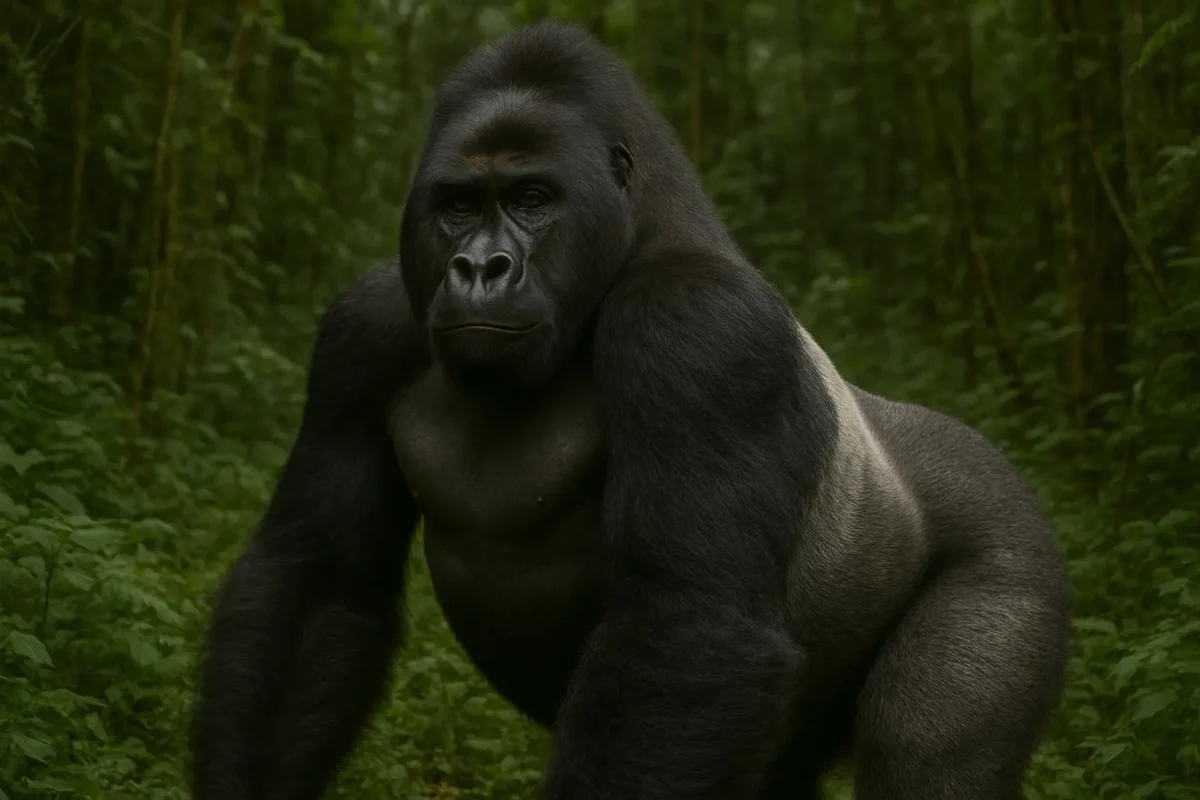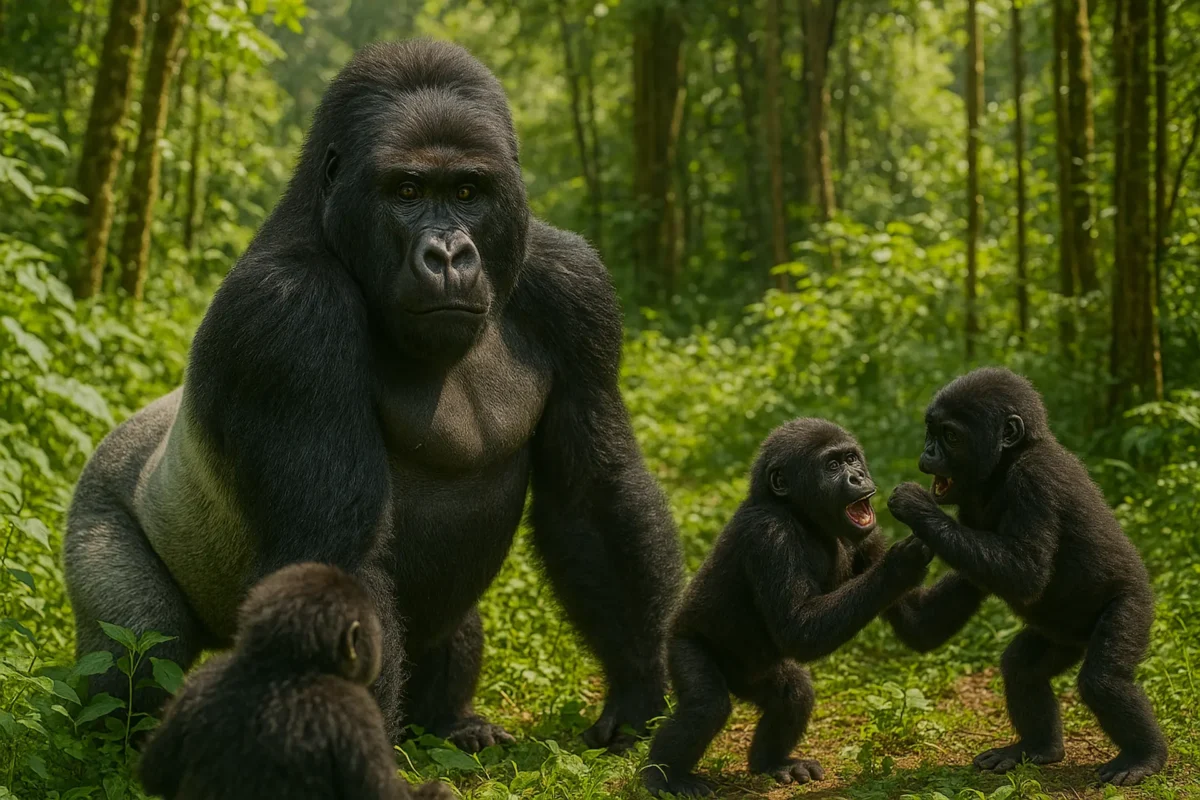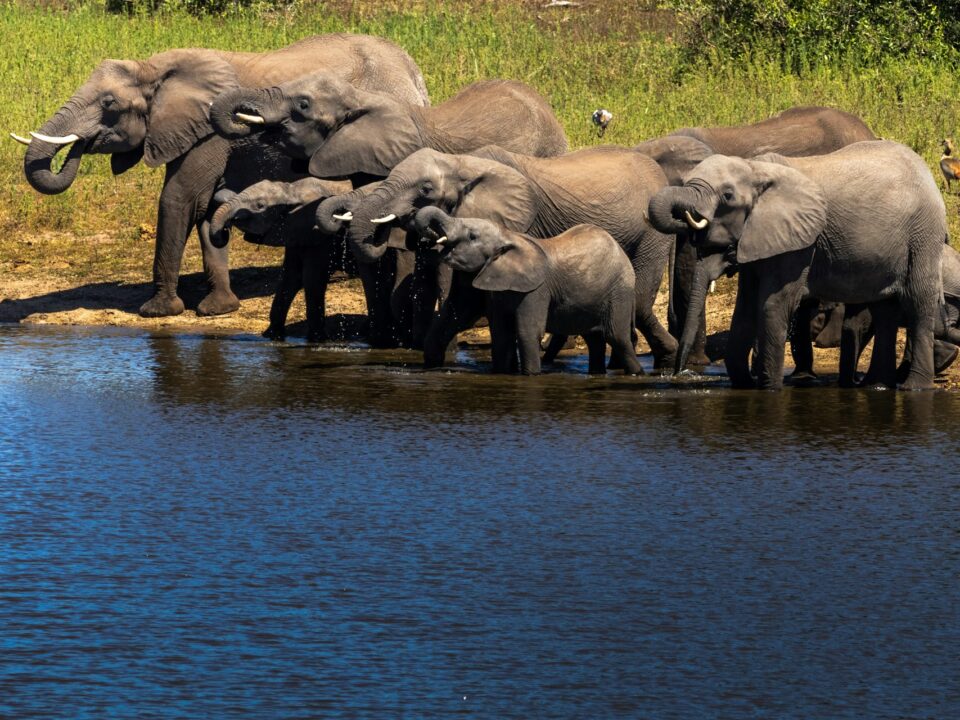
Silverback gorillas: Kings of the Mountain
A silverback gorilla refers to an adult male mountain gorilla of the gorilla troop. They derive their name ‘silverback’ from the striking silver-grey hair that develops on their backs as they reach full maturity, typically around 12 to 14 years of age. This unique coloration, combined with their impressive size, makes them easily identifiable even during a gorilla trekking adventure in Uganda, Rwanda, or the Democratic Republic of Congo.
A Silverback gorilla is are Leader: More Than Just Muscle
A silverback gorilla isn’t just an impressive physical specimen; they are the undisputed leaders of their family groups. The strongest and most dominant silverback takes on the crucial role of guiding and protecting his troop, making all the important decisions regarding their movements, feeding, and safety.

Their leadership is multifaceted:
- Navigation & Foraging: The silverback guides the troop to the richest feeding grounds, remembering seasonal fruit trees and fresh bamboo shoots across vast territories.
- Conflict Resolution: He acts as the ultimate arbiter in internal disputes, using vocalizations, chest-beating displays, and sometimes physical intervention to maintain harmony within the family.
- Protection: Perhaps their most vital role is defense. A silverback will fiercely protect his troop from external threats, be it a leopard, human poachers, or even another rival gorilla group. They are the first line of defense, demonstrating incredible courage and self-sacrifice.
Witnessing these intricate dynamics firsthand is truly a highlight of any gorilla trekking tour. You might observe a playful juvenile seeking the silverback’s attention, or a protective mother positioning her infant close to his reassuring presence. It’s not uncommon to observe younger, ambitious silverbacks challenging the reigning leader, vying for control of the group. These interactions offer a profound glimpse into the deep social bonds that tie these magnificent creatures together. These displays of strength and dominance are a natural part of their social structure and offer a fascinating glimpse into their complex lives. Encountering these magnificent creatures in their natural habitat and observing the silverback gorilla’s leadership in action is an unforgettable experience
The Path to Dominance: Challenges and Succession of a Silverback gorilla
While the reigning silverback gorilla holds supreme authority, his position isn’t always unchallenged. Younger, ambitious males within the group, often referred to as “blackbacks” (males who haven’t yet developed their silver saddles), might attempt to assert their dominance as they mature. These challenges are a natural part of gorilla social structure and can sometimes lead to intense, though rarely fatal, confrontations.
In some cases, if a silverback is overthrown or passes away, the troop may fragment or a new leader will emerge, often a dominant blackback or an external silverback seeking to establish his own family. Understanding these complex social hierarchies adds another layer of fascination to your encounter with these intelligent primates.
A Day in the Life of a Silverback gorilla: Diet, Rest, and Roaming
Life for a silverback gorilla and his troop revolves around a surprisingly peaceful rhythm of foraging, resting, and social bonding.
- Diet of a Gentle Giant: Despite their immense size and strength, silverback gorillas are primarily herbivores. Their diet consists overwhelmingly of vegetation found in their lush mountain habitat. They are voracious eaters, consuming vast quantities of:
- Leaves and Stems: Bamboo shoots, thistles, wild celery, and nettles form the bulk of their meals.
- Roots and Bark: They expertly strip bark from certain trees and dig for nutritious roots.
- Fruits: When available seasonally, fruits are a highly prized treat.
- Occasionally, small insects: While not a primary food source, they might consume ants or termites incidentally while foraging. They spend a significant portion of their day, sometimes up to 30%, just eating to sustain their massive bodies.
- Rest and Recreation: After a few hours of intensive feeding, the troop will typically settle down for a period of rest. This is when you’ll often see the most endearing social interactions: grooming, playful wrestling among juveniles, and the silverback observing his family with a watchful eye. They construct new nests each night from surrounding vegetation, offering a fresh, comfortable sleeping spot.
- Nomadic Lifestyle: Gorilla troops are constantly on the move, though their range is relatively small compared to other large primates. The silverback determines the day’s travel, leading his family through dense vegetation, forging new paths, and ensuring they have access to sufficient food and water.
Facts About A Silverback Gorilla:
- Impressive Stature: An adult silverback gorilla can stand up to 6 feet tall (1.8 meters) and a silverback gorilla weight is over 400 pounds (180 kg), making them the largest living primates.
- Incredible Strength: Pound for pound, a silverback is estimated to be 10 times stronger than an average human.
- Unique Nose Prints: Like human fingerprints, each gorilla has a unique nose print, which researchers use for identification.
- Gentle Giants: Despite their formidable appearance, mountain gorillas are generally calm and shy. Charges are typically bluffs intended to deter perceived threats.
- Long Lifespan: In the wild, silverbacks can live for over 35 years, and even longer in captivity.
Special Fun Fact: The Surprising “Nose Print” Identity
While we humans rely on fingerprints, each and every silverback gorilla (and all mountain gorillas, for that matter!) possesses a completely unique identifier: their nose print! Just like our fingerprints, the intricate patterns of ridges and creases on a gorilla’s nose are distinct to every individual. This unique feature is incredibly valuable to researchers and conservationists, allowing them to accurately identify and monitor individual gorillas within a troop, track their health, social changes, and even determine population sizes without intrusive tagging or collaring. So, when you’re observing a silverback up close, remember you’re looking at a living ID card!
Conservation: Protecting the Silverbacks
Despite their strength and resilience, mountain gorillas, and by extension, the silverback gorilla, remain critically endangered. Threats like habitat loss, poaching, and disease continue to pose significant risks to their survival.
However, thanks to dedicated conservation efforts by organizations like the Gorilla Doctors, local communities, and national park authorities in Uganda (Bwindi Impenetrable and Mgahinga Gorilla National Parks), Rwanda (Volcanoes National Park), and Congo (Virunga National Park), their numbers are slowly recovering. Your participation in a gorilla trekking safari directly contributes to these vital conservation initiatives through permit fees, which fund anti-poaching patrols, community development, and veterinary care.
Plan Your Gorilla Trekking Adventure
Encountering a silverback gorilla in its natural habitat is an unparalleled wildlife experience, leaving an indelible mark on your soul. It’s a privilege to witness these gentle giants up close, to observe their intricate social lives, and to feel the raw power of nature.
Ready to witness the kings of the mist? Explore our gorilla trekking tours in Uganda, Rwanda, and the Democratic Republic of Congo, and contribute directly to the survival of these incredible creatures.
Frequently Asked Questions (FAQ) about Silverback Gorillas & Gorilla Trekking:
What is a silverback gorilla?
The term “silverback” refers to an adult male mountain gorilla that has reached maturity, typically around 12-14 years of age, and developed a distinctive saddle of silver-grey hair on his back. They are the dominant leaders of gorilla family groups.
How strong is a silverback gorilla?
Silverback gorillas possess incredible strength, estimated to be 4-10 times that of an average human. They can lift over 800 kg (1760 lbs) and use their power for foraging (like felling small trees) and defending their troop.
How big is a silverback gorilla?
A silverback gorilla typically stands between 4 to 6 feet (1.2 to 1.8 meters) tall when standing upright, with an impressive arm span that can stretch up to 8.5 feet (2.6 meters).
What do silverback gorillas eat?
Silverback gorillas are primarily herbivores. Their diet consists mainly of leaves, stems, roots, bark, and bamboo shoots. They occasionally supplement their diet with fruits and small insects like ants or termites.
What is the average lifespan of a silverback gorilla?
In the wild, silverback gorillas typically live for 35 to 40 years. In captivity, with proper care, some have been known to live for 50 years or even longer.
How do silverback gorillas lead their troop?
A silverback gorilla leads by example, guiding the troop to food sources, mediating conflicts within the family, and fiercely defending them from perceived threats. They make all key decisions for the group’s movements and safety.
Where can I see silverback gorillas in their natural habitat?
Silverback gorillas (specifically mountain gorillas) can only be found in the wild in three countries: Uganda (Bwindi Impenetrable National Park and Mgahinga Gorilla National Park), Rwanda (Volcanoes National Park), and the Democratic Republic of Congo (Virunga National Park).
Is gorilla trekking safe?
Yes, gorilla trekking is considered very safe. Gorillas are habituated to human presence and rarely show aggression if rules are followed. Park rangers and guides ensure your safety and provide strict guidelines to minimize any risk. The most common “danger” is a slip or fall on uneven terrain.
Why are gorillas endangered?
Gorillas are endangered primarily due to habitat loss, poaching, and disease transmitted from humans.
What are the main types or species of gorillas?
There are two main types of gorillas: the Eastern Gorilla and the Western Gorilla. Each species has two subspecies: Western Lowland and Cross River Gorillas (Western species), and Mountain and Eastern Lowland (Grauer’s) Gorillas (Eastern species)
What is the best time to go for gorilla trekking in Uganda or Rwanda?
While gorilla trekking is possible year-round, the dry seasons (June to September and December to February) are generally considered best. Trails are less muddy and slippery, making the trek easier. However, the wet seasons offer lush scenery and potentially easier gorilla sightings as food is abundant lower down the slopes.
How much does a gorilla trekking permit cost?
Gorilla trekking permit costs vary by country. As of current information (prices can change), a permit in Uganda is generally cheaper than in Rwanda, with DR Congo being the most affordable. It’s crucial to check the latest prices with the respective wildlife authorities or your tour operator.
How long does a gorilla trekking experience last?
The actual trek to find the gorillas can range from 2 to 8 hours, depending on where the gorilla family is located that day. Once found, visitors are allowed one precious hour in the presence of the gorillas to observe and photograph them.
What should I pack for a gorilla trek?
Essential packing for gorilla trekking includes waterproof hiking boots, long-sleeved shirts and pants (to protect against thorns and insects), gardening gloves, a rain jacket, insect repellent, a hat, sunscreen, plenty of water, and snacks. A good camera (without flash) and binoculars are also highly recommended.
Why are mountain gorillas endangered, and what conservation efforts are in place?
Mountain gorillas are critically endangered primarily due to habitat loss, poaching (often by snares set for other animals), and disease transmission from humans. Intensive conservation efforts, funded largely by tourism, include daily monitoring, anti-poaching patrols, veterinary care (like Gorilla Doctors), and community engagement programs to reduce human-wildlife conflict.


